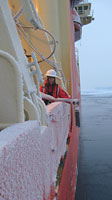

 | |||||||||||||||||
|
|
Journals 2008/2009Roy Arezzo
July 21, 2008 Woke early and video taped the back-to-back, Blake trawl, Plankton tow and Tucker trawl on the other watch. It was a thrill to see our nets come in and out of the water, hauling up live treats for us to see. As a rule we do only one deployment at a time, but on the NBP, turn over time can be impressively quick with ample deck space, separate winches and a great deck crew. The Tucker trawl is large net with a 200 micron mesh size (2/10th of a millimeter) used to collect plankton. The mesh size allows for capturing mostly larger plankton, including zooplankton and meroplankon (larvae of larger animals that float around as plankton before settling into their adult life). Since algae have lots of structures that extend their surface area they often stick to the net and other critters ending up in the sample. Linda of North Carolina State has been crowned the Tucker Queen and she is up for each deployment to oversee the operations and collect the samples. What makes the Tucker trawl special is that it is three nets in one. The first net is open when the net enters the water will collect plankton until it is time to open another net. The other two nets attached can be rigged to deploy at different depths. We let out enough cable to bring the net down near the bottom, which for most of our sampling is around 600 meters. Mud will clog the small mesh and rocks can tear the material, so communication with bridge and winch operator is important to avoid the net actually touching bottom. When the net reaches the greatest depth in the trawl area, the first messenger is sent down, which hits a release that close the first net and opens the second net. The trawl is brought up slowly from 600 to 300 meters at which time a second messenger is sent down which closes the middle net and opens the third net for the remainder of the trawl in the upper parts of the water column until it surfaces. The Tucker trawl drags for about 1-2 km, which takes over an hour and about 1300 meters of wire. The nets have flow meters to record the volume of water that passes through for quantitative analysis of plankton per volume.
The plankton is collected in plastic containers at the cod ends and of each net. Like most other sampling that goes on here, there is a host of projects going on simultaneously and thus a variety of end results for each sample. Linda uses a sorting wheel that divides the sample in to quarters. Linda's graduate work back in North Carolina, involves studying deep sediment feeding by sea cucumbers specifically a borrowing Holothurian called Ypsilocucimus (fun to say and spell). She hopes to find the larvae of holothurians in the plankton net, but she is also interested in zooplankton migration patterns in response to light. In many parts of the world plankton vertically migrate in the water column in response to food availability, predators and water quality. Light intensity is a common cue for migration but since winters in Antarctica are short on light we are interested to learn how this affects migration. Some of the samples from the Tucker trawl will go to other labs for DNA analysis and biodiversity studies. There is interest in recruitment and reproduction studies of different larvae between summer and winter seasons in happening up in Sarah Mincks' lab up in Fairbanks, Alaska. Dave's lab at NCSU will look at the carbon-14 in the plankton to connect nutrient flow on the bottom with the plankton above.
In addition to the large Tucker Trawl we pull a smaller plankton net with a 20 micron mesh size down about 50 meters to target phytoplankton at each study site. Alyssa, also a graduate student from NCSU, is always up for a plankton pull. She will spend time back in the states trying to separate out and identify the different species of phytoplankton in the upper water column. The phytoplankton is a major contributor to the deep sea upper surface of detritus. As plankton die they rain down creating a layer of fresh food for the deposit feeders.
The rest of my day involved consecutive Megacores (3) and Box Cores (2) so I was basically covered in mud for seven hours straight. We are finishing up Station E before heading north to Station B. We put some fish in the aquarium with our sea pig and a few gastropods that have taken to living on the top edge of the tank for a great view of their snail bodies. The best view today was when Rhian was sieving the sediment from the Box Core. Responding to the spray of the hose where green glowing Phosphorescent nematodes (small round worms) in an excited state for a little more light on deck. |
||||||||||||||||



